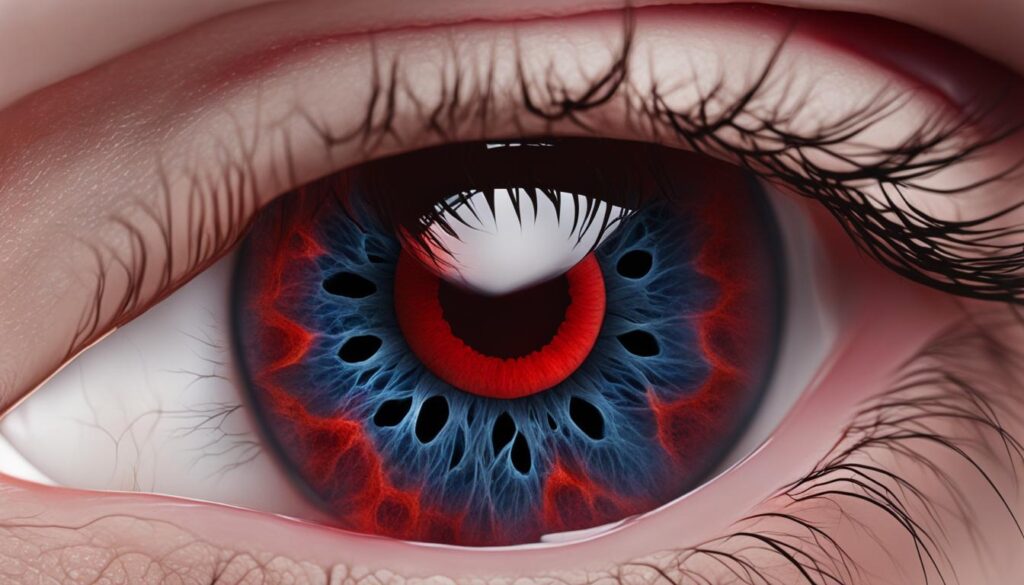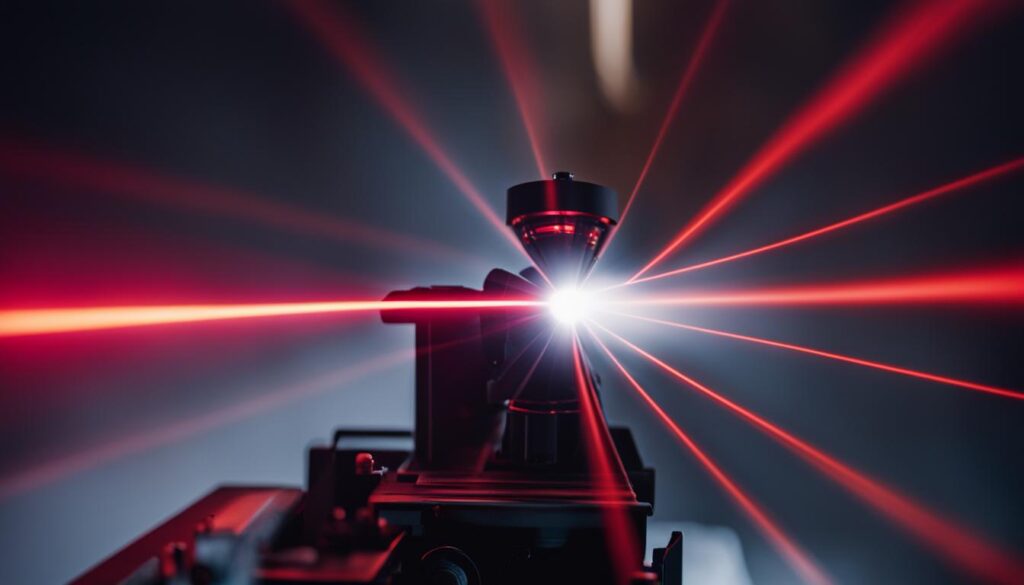The vitreous humor is a remarkable substance that plays a crucial role in maintaining the health and function of our eyes. It is a clear gel-like substance that fills the majority of the eye, providing structural support and preserving the shape of the eyeball. But have you ever wondered why the vitreous humor is so clear? Let’s delve deeper into the fascinating world of vitreous humor clarity and transparency.
Key Takeaways:
- The vitreous humor is a clear, gel-like substance that fills the eye, maintaining its shape and providing structural support.
- It is composed of 99 percent water, collagen, and hyaluronic acid, giving it a gelatinous consistency.
- The vitreous humor’s transparency allows light to pass through it without scattering or distortion, ensuring clear vision.
- Vitreous hemorrhage can affect the clarity of the vitreous humor, leading to visual disturbances and other symptoms.
- Treatment options for vitreous opacities include observation, vitrectomy, and YAG laser vitreolysis.
Vitreous Anatomy and Structure
The vitreous body is a vital component of the eye, playing a crucial role in maintaining its shape and supporting the retinal tissue. Comprehending the composition and structure of the vitreous humor can provide valuable insights into its transparency and overall function.
The vitreous body is defined by the internal limiting membrane of the retina, the nonpigmented epithelium of the ciliary body, and the posterior lens capsule and lens zonular fibers. It represents approximately 80 percent of the eye’s volume and has a volume of around 4 ml.
The vitreous humor, a gel-like substance, is firmly attached to the retina at three places, providing necessary support and stability to the delicate retinal tissue.
The composition of the vitreous humor plays a significant role in its transparency and clarity. It primarily consists of water, comprising about 99 percent of its composition. The remaining 1 percent includes collagen and hyaluronic acid, which contribute to its gelatinous consistency and optical transparency.
The vitreous body’s exceptionally transparent structure allows light to pass through it without obstruction, enabling clear vision. This transparency ensures that light enters the eye and reaches the retina without scattering or distortion.
Mechanisms of Vitreous Hemorrhage
Vitreous hemorrhage refers to the presence of blood in the vitreous humor, the gel-like substance that fills the majority of the eye. It can occur through different mechanisms, leading to a disruption in the clarity of the vitreous humor.
One of the main causes of vitreous hemorrhage is the presence of abnormal blood vessels that are prone to bleeding. This is commonly seen in conditions such as diabetic retinopathy and retinal vein occlusion. In these diseases, the abnormal vessels are fragile and can rupture, resulting in the leakage of blood into the vitreous.
Another mechanism involves the rupture of normal blood vessels under stress. This can occur during a posterior vitreous detachment, which is the separation of the vitreous humor from the retina. The separation process can create tension on the blood vessels, causing them to rupture and bleed into the vitreous.
In addition, blood can enter the vitreous from an adjacent source. For example, retinal macroaneurysms, which are abnormal dilations of retinal blood vessels, can rupture and release blood into the vitreous. Similarly, choroidal neovascularization, the formation of abnormal blood vessels beneath the retina, can also result in the extension of blood into the vitreous humor.
These various mechanisms can lead to vitreous hemorrhage and compromise the clarity of the vitreous humor. The presence of blood in the vitreous can cause visual disturbances and affect overall vision. Understanding these mechanisms is crucial for the diagnosis and management of vitreous hemorrhage.

| Cause | Explanation |
|---|---|
| Abnormal blood vessels | Bleeding from fragile vessels in conditions like diabetic retinopathy and retinal vein occlusion. |
| Rupture of normal vessels | Under stress, blood vessels can rupture during a posterior vitreous detachment. |
| Blood from adjacent source | Blood can extend into the vitreous from retinal macroaneurysms or choroidal neovascularization. |
Symptoms and Diagnosis of Vitreous Hemorrhage
The symptoms of vitreous hemorrhage commonly include painless floaters and/or visual loss. Floaters may be described as cobwebs, haze, shadows, or a red hue. Visual acuity and visual fields may be limited, and patients may experience worsening vision in the morning as blood settles to the back of the eye.
The presence of vitreous hemorrhage can be readily detected through a thorough eye examination, which may include:
- Indirect ophthalmoscopy
- Scleral depression
- Gonioscopy
- B-scan ultrasonography if the view of the posterior pole is obscured by blood
The symptoms and diagnostic procedures mentioned above help in identifying the signs of vitreous hemorrhage and determining the appropriate treatment and management options for patients.
Note: The image above illustrates common symptoms of vitreous hemorrhage for easy identification and reference.
Treatment Options for Vitreous Opacities
The treatment approach for vitreous opacities depends on the severity of symptoms and their impact on the patient’s quality of life. Observation, vitrectomy, and YAG laser vitreolysis are commonly employed treatment options.
Observation is often the initial approach for patients with mild floaters. Many individuals learn to tolerate and ignore these floaters over time. Regular monitoring is recommended to ensure that the symptoms do not worsen or significantly affect visual function.
Vitrectomy may be recommended if symptoms persist or significantly impact visual function. This surgical procedure involves the removal of the vitreous humor and its replacement with a clear fluid. By removing the affected vitreous humor, the surgeon aims to alleviate symptoms and improve vision.
YAG laser vitreolysis is an alternative treatment option for patients with large floaters that significantly impact visual function. This minimally invasive procedure uses laser energy to break up and disintegrate the floaters, making them less noticeable and improving visual clarity.
The choice of treatment depends on individual patient factors, such as the severity of symptoms, the impact on quality of life, and the presence of any underlying eye conditions. A thorough examination by an ophthalmologist is essential to determine the most suitable treatment option for each patient.

Conclusion
The vitreous humor, with its clear gel-like nature and transparency, plays a vital role in maintaining optimal vision and eye health. Its unique composition allows light to pass through without distortion, ensuring clear vision for the individual. However, vitreous opacities can cause visual disturbances and impact the quality of life for some people.
Fortunately, there are treatment options available to alleviate these symptoms and improve visual function. Observation is often the initial approach, allowing patients to adapt to mild floaters over time. In more severe cases, vitrectomy, a surgical procedure involving the removal of the vitreous humor and its replacement with clear fluid, may be recommended.
Another treatment option is YAG laser vitreolysis, which employs laser energy to break up and dissolve large floaters. The choice of treatment should be based on individual patient factors and the severity of symptoms. Consulting with an ophthalmologist will help determine the most suitable course of action for each individual.
FAQ
Why is the vitreous humor clear?
The vitreous humor is clear because it is composed of 99 percent water, along with collagen and hyaluronic acid. This composition gives it a gelatinous consistency and allows light to pass through it without scattering or distortion, ensuring clear vision.
What is the structure of the vitreous body?
The vitreous body is defined by the internal limiting membrane of the retina, the nonpigmented epithelium of the ciliary body, and the posterior lens capsule and lens zonular fibers. It represents 80 percent of the eye’s volume and has a volume of approximately 4 ml. It is firmly attached to the retina at three places, providing support and stability.
How does vitreous hemorrhage occur?
Vitreous hemorrhage can occur due to abnormal blood vessels that are prone to bleeding in diseases like diabetic retinopathy and retinal vein occlusion. Normal blood vessels can also rupture under stress, particularly during a posterior vitreous detachment. Additionally, blood can enter the vitreous from adjacent sources like retinal macroaneurysms or choroidal neovascularization.
What are the symptoms of vitreous hemorrhage?
Common symptoms of vitreous hemorrhage include painless floaters and/or visual loss. Floaters may be described as cobwebs, haze, shadows, or a red hue. Visual acuity and visual fields may be limited, and some patients may experience worsening vision in the morning as blood settles to the back of the eye.
How is vitreous hemorrhage diagnosed?
The presence of vitreous hemorrhage can be detected through a thorough eye examination, which may include indirect ophthalmoscopy, scleral depression, gonioscopy, and B-scan ultrasonography if the view of the posterior pole is obscured by blood.
What are the treatment options for vitreous opacities?
The treatment approach for vitreous opacities depends on the severity of symptoms and their impact on the patient’s quality of life. Observation is often the initial approach, with patients learning to tolerate and ignore mild floaters over time. If symptoms persist and significantly affect visual function, vitrectomy (removal of the vitreous humor) may be recommended. Another treatment option is YAG laser vitreolysis, which uses laser energy to break up and disintegrate large floaters.
How important is the clarity of the vitreous humor?
The clarity of the vitreous humor is crucial for maintaining optimal vision and eye health. Its gel-like consistency and transparency allow light to pass through without distortion, ensuring clear vision. While vitreous opacities can cause visual disturbances, treatment options such as observation, vitrectomy, and YAG laser vitreolysis are available to alleviate symptoms and improve visual function.
